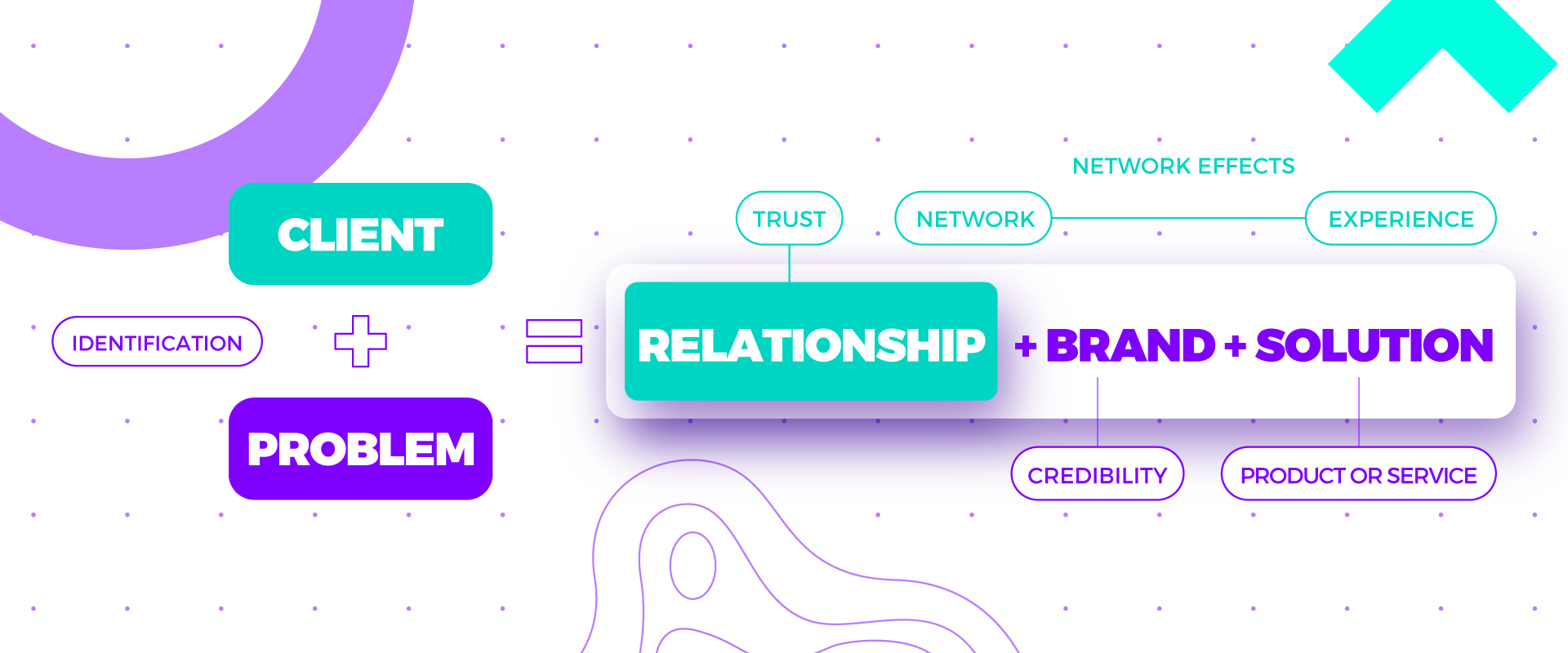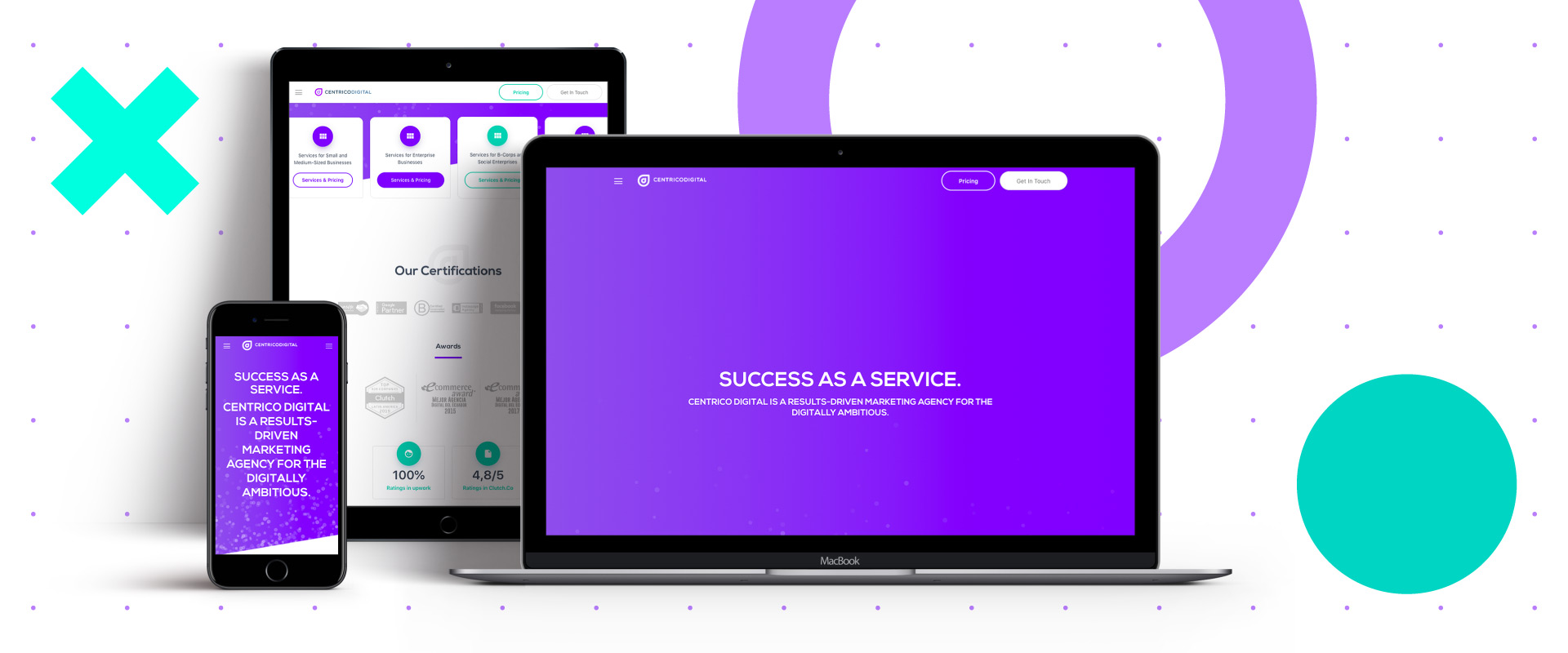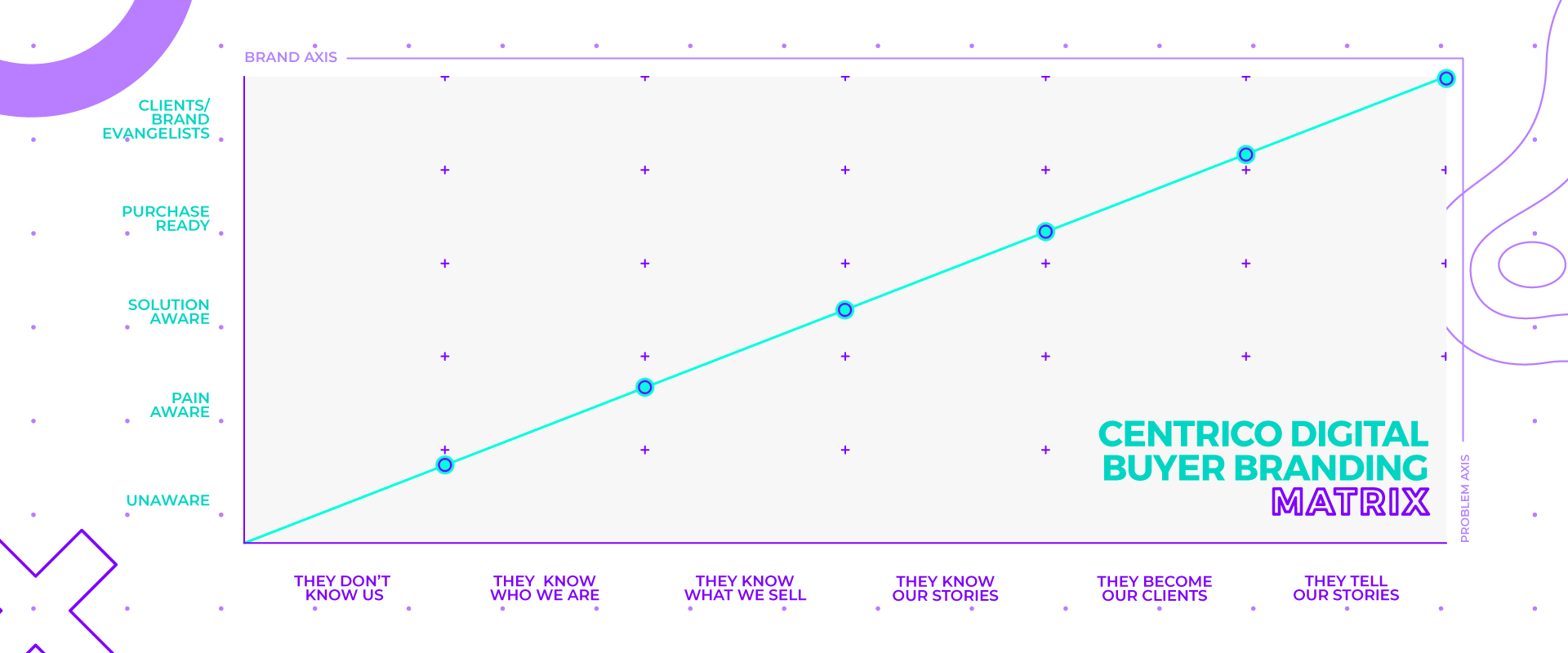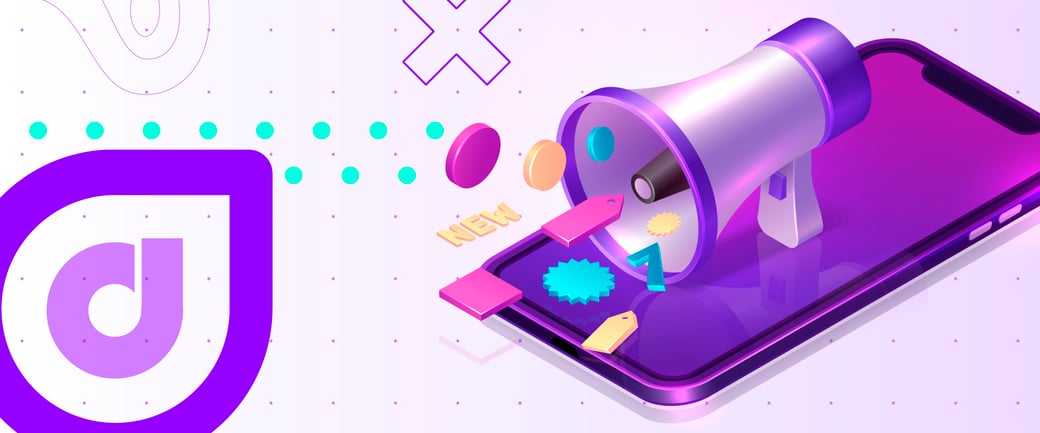1. First, Start with a Strategy
The greatest temptation for any marketing team is to act as hunter-gatherers rather than builders. The hunter-gatherers scour the forest looking for resources before quickly and oftentimes thoughtlessly moving on to the next landscape. They’re not necessarily guided by any overarching philosophy, just urgency: they’re trying everything and anything to see what works. Our experience at Centrico Digital has taught us that hunter-gatherers are more successful as tacticians in the B2C space than in the B2B world for the simple reason that the buyer’s journey for low-cost, impulse-driven purchases is far more straightforward than the B2B SaaS buyer’s journey, which involves multiple touch-points through multiple channels targeting multiple stakeholders over a longer period of time. Also, B2B marketing is often more niche: success comes from building and harvesting relationships, which is ultimately a strategic activity.
Whilst we do want to invest in experimentation in our B2B strategy, we also need to do a fair amount of planning to be successful, rather than just hope it happens. As the saying goes, “give me six hours to chop down a tree, and I will spend the first four sharpening the axe”. We at Centrico Digital have written extensively about how to develop winning B2B strategies: you can find our whitepaper on the topic here. Having a strategy document is not only important to help us prioritize our activities; it also acts as a map we can share internally to help explain why we’re doing what we’re doing. More on that later (see internal comms). Our larger point here is, before you get started, have a why. At Centrico Digital, we use the following formula to organize how we build strategies and the why behind each activity. You can read more about our proprietary formula in the aforementioned whitepaper.

The Centrico Digital B2B Digital Marketing Strategy Formula
2. Second, your website is your anchor
We could easily argue that websites are not as important as they once were since companies can have so many distinct touchpoints within the customer journey beyond our increasingly old school www address. Nonetheless, websites are still important because they center the entire strategy for our internal and external audiences. Websites need to quickly and easily establish not only what your organization does and what it stands for, but also what outcomes your business produces and for whom. Our positioning statements, storytelling efforts, and promised impact are front and center on our website. Also included on our websites is the social proof that endows our brand with credibility. Lastly, websites are often where users convert into leads or customers. We must therefore make it fast, easy, and intuitive for users to take the actions we’re nudging them to take.

Though there can be a desire to build dozens of pages on a website to explain everything an organization does, especially when there are too many cooks in the website development kitchen, numerous studies have shown that users spend on average between 15 seconds and 2½ minutes on a website. With that in mind, our elevator pitch must be sharp, our message succinct, and each page valuable. Remember: every page we build requires maintenance over time. For B2B SaaS websites, the fewer pages we have, the better.
We break websites down into the following categories:
- Homepage
- Landing Pages, including product pages.
- Blog / Content Pages
- Marketing Assets (i.e. case studies, product documentation, etc).
Websites are also important for two other reasons: first, the data we can gather from our websites tells us a lot about how users behave and interact with our content before they convert. We can use our websites to understand and optimize our buyer’s journey. Software like Mix Panel allows us to have a deep and granular understanding of how users interact with websites. We’ll likely have users coming to our websites from a variety of sources; any optimization we make has the possibility of increasing ROI of both paid and earned traffic from all channels.
Website optimization isn’t only about where we place buttons or how fast the page loads. A major part of website success is copywriting. With such short visits to our website, users need a language that is clear, concise, and action-oriented. Too many words on a website can have the visual impact of overwhelming the user, making them less interested in reading your pitch. Unclear language can cause users to quickly surf away to a website whose product or service they can understand more quickly.
If you already have clients, figuring out how they talk about and perceive your value proposition is the best place to start to build strong website copy. The importance of mimicking your clients’ language is often overlooked by marketers who trust in their own intuition over the need to undertake what they see as unnecessary anthropological studies of their audiences. These marketers are making a critical mistake by assuming we are the buyer persona and not a buyer persona. The role of marketing in developing and enabling the feedback loop with clients begins with website copy. The more we can move our companies away from building products and services based on intuition and towards designing them for clients, the more success we’ll have in the long term. The Nike Master Trainer Branden Collinsworth is fond of saying “Yoga is a practice not perfect”. Marketing is similar: it’s a practice, not a perfect, and it is the practice of strengthening the feedback loop.
If you’re looking for a great website to model your own, we recommend checking out Tableau’s website. We like their action-oriented language, clear conversion path, and ability to explain their value proposition to distinct audiences.
3. Content Marketing is the Voice of Your Brand
 In a conversation with one of our copywriters, we were discussing the voice of the brand when he said, “80% of a brand’s voice comes from what they talk about, not how they say it.” Old school marketers can fret about voice, but the truth is that people remember what you said more than the subtleties of how you said it. After the website, content marketing stitches together our marketing strategy, informing our SEO strategy and social media activities. Whereas in the pre-digital age organizations could afford the luxury of buying user’s attention and talking exclusively about themselves, in the post-digital age organizations must create value for their audience in order to earn their attention.
In a conversation with one of our copywriters, we were discussing the voice of the brand when he said, “80% of a brand’s voice comes from what they talk about, not how they say it.” Old school marketers can fret about voice, but the truth is that people remember what you said more than the subtleties of how you said it. After the website, content marketing stitches together our marketing strategy, informing our SEO strategy and social media activities. Whereas in the pre-digital age organizations could afford the luxury of buying user’s attention and talking exclusively about themselves, in the post-digital age organizations must create value for their audience in order to earn their attention.
With content marketing, there is a temptation to look at the top-ranked keywords and simply re-write content others have already written. While rewriting content may garner some organic traffic over time, such an approach leaves us competing as a generic information provider when our goal is to build brand recognition with a specific audience and generate conversions. When building content marketing strategies in 2020, we have to create unique content that adds value to our audience's lives. Producing unique data, industry reports, surveys, and other types of research can help earn the relationships we seek to form.
Beyond being unique, the content we produce has to be visually appealing and should answer key questions our audience may have. Once we invest in putting together original content, our creative team not only has fodder for their social media strategy but can also use their skills to reproduce the content in different formats across many platforms.
4. Search Engine Optimization – Your Compound Interest Account

Search Engine Optimization (SEO) is another field that produces a marked contradiction: on the one hand, for agency partners like ourselves, it can be hard to convince our clients to focus on SEO because the results are not immediate. At the same time, an internal survey of B2B clients that have worked with us for 3+ years showed that, on average, 35% of leads come from organic traffic derived from SEO activities. SEO is sort of like having a savings account with compound interest: in the short term, the gains are negligible. In the long term, the results are life-changing.
Having worked at Google and studied SEO inside and out, I can confidently say that success in SEO does not require black magic or secret tricks. Yes, there are black and grey hat SEO practices that may produce success in the short and medium term. I have also seen websites that use such practices fall from Google’s grace overnight, losing the majority of their traffic with an algorithm update and often never recovering their former heights. Google is smarter than most of us and whatever shortcuts we find to the top of search engine results pages will eventually be closed.
My conclusion after 12 years of focusing on SEO is that success is built on a long-term plan of producing high-quality content on impeccably optimized websites. My complimentary conclusion is that most organizations do not have the patience to stick with a winning strategy. Instead of exploring the outer realms of ethical SEO practices, our suggestion is to obsess over the fine details.
For example, great SEO starts with a highly optimized website. Whereas many website developers will tell you that a load-time over under 3 seconds is good enough, know that Google obsesses over microseconds, and you should as well. While building external links is not the strategy it once was, backlinks are still important. Don’t allow that statement to lead you down a path of paying someone to add comments to articles on popular publications that link back to your content. Also, avoid becoming entangled in nebulous link farm schemes. Building mutually beneficial relationships with a community of content producers, focusing on great storytelling through digital PR (see below), helps ensure your SEO improves through quality links.
Great SEO starts with keyword research, and like an author judged on her entire body of work, Google and Bing want to see you’ve produced high-quality content over time. The best way to build a strong content library is to focus on long-tail keywords, a fact all the more important as voice search consumes a larger share of search volume. All of the great long-tail-focused content you create will also influence how Google values and indexes your short-tail-focused content. Another means to determine content quality is how much people want to share your content. The building or contributing to online communities will help ensure you have a distribution network through which to spread your content.
Finally, internal links are also still important, as they tell Google what content you most value. Whenever you produce new content, you’ll likely have to go back and update old content, both with new information as well as new links. Though content maintenance can be tedious, Google values it. The extra effort required to keep your content fresh and relevant will ultimately pay off. Think of your SEO work as a garden: not only does it need to be tended to thrive, the diversity and health of all your plants ensure fertile soil for future growth.
SEO isn’t limited to what we’ve discussed here. A website’s URL structure, meta-data, accessibility, among other factors all influence how well our page ranks on search engine results. You can receive direct feedback from Google on the technical health of your website here. Our main takeaway for clients is this: there are no secrets to SEO, only, persistence, patience, and the pursuit of impeccable content.
5. Great Social Media Is More Than Your Corporate Accounts

Social media is a broad topic; if we’re discussing social media and limiting ourselves to thinking about what posts are going to show up on our organization’s organic Facebook feed, we’re probably thinking about social media too narrowly. Most social media networks have been restricting organizations’ organic reach for some time. A better way to think of social media is really content distribution and community organization.
In Centrico Digital we are guided by a few basic premises: first, through our social media activities, we should be sharing our knowledge and answering questions. We generally begin social media planning by looking at all of the unique ways we can take the work we’ve done in our content marketing strategy and get it out into the world. Can we turn that white paper into a 30-second animated video? Is there a way to take our market research and convert it into a beautiful carousel ad? How can we make it worth people’s time to follow and engage with us? How can we accompany people through the process of solving problems and demystifying complex tasks? As an organization, we may have a limited number of insights and data we want to share. The ways in which we can present and distribute those ideas are endless.
Second, we should be building a community through meaningful relationships. The instinct to interact with a company does not come naturally to most people. We see online brands as hollow nameless corporations that we don’t really want to interact with except when we require customer service. Organizations, therefore, have to invite people to interact with them and make doing so second nature. Here is where social selling comes into play: organizations are ultimately collections of individuals, and our relationships are expressed and maintained through those individuals. Are we able to create content that’s engaging enough our employees and stakeholders want to share it? Are we coordinating with our employees, especially our salespeople, to ensure they have the content to be able to nurture their relationships?
Third, who are the influencers in our field? When I say “influencer marketing”, you may immediately think of a reality TV host selling makeup or a celebrity pushing his tequila brand. Such a view of influencer marketing is too narrow. Whatever conversations our organization is interested in, somewhere there are individuals who have built a community of individuals interested in that topic, and we call them influencers. Influencers can be judged based on three criteria: their reach, their authority, and their relevance. Not all influencers command massive audiences but they may still be well respected by a small yet influential group of decision-makers. Not all influencers charge for access to their audience but may be open to other forms of mutually beneficial engagement. Influencer marketing is another way of thinking about word of mouth, and all social media is simply the amplification of word of mouth marketing.
To conclude, great social media marketing boils down to how we design our content distribution, community engagement, and relationship forming and harvesting activities. In addition, great social media is driven by a brand concept: people follow your brand because they want more of the high-quality content you’ve given them. The challenge is both one of analysis and creativity. The opportunity for creativity is endless.
6. Paid Advertising

Paid advertising is usually the cornerstone of any digital marketing strategy because its results are more immediate. With paid advertising, we usually begin by asking what we seek to achieve through our two main tools, search, and discovery. By search, we refer to search engines of all kids that connect users with the information they are actively seeking. By discovering, we refer to the means by which we introduce our brand, content, and offerings to users without them initiating a search. With search, our strategy may be straightforward: we have users searching for information about problems, solutions, and hopefully branded keywords (and yes, you should always spend money on your branded keywords for the simple reason that your competitors will if you don’t). Search as a paid channel is exciting because it often represents the last conversion or point of contact before a user becomes a lead. We shouldn’t, however, limit our thinking about the investment in search as a mechanism to generate leads. A lot of other objectives, including branding, can be achieved through the creative use of Search Engine Marketing.
Discovery is the other subfield within the realm of paid advertising, and like social media, the opportunity to explore discovery through creativity is endless. Getting our content in front of decision-makers, using sophisticated targeting, and employing account-based marketing requires us to understand how we draw people closer to our organization. At Centrico Digital, as we’ve discussed in our aforementioned B2B strategy whitepaper, we conceive of the buyer’s journey as a two-dimensional experience in which we move across the chessboard via a branding and problem axis.

With paid advertising, we need to escape the idea that we’re just paying for leads, and understand that paid media is an opportunity for us to strengthen our top and middle of the funnel goals, as well as create new positive and memorable interactions with our brand. Also, between 10% and 20% of our paid budget should be spent on long-shot and out-of-the-box thinking in order to ensure we’re undertaking enough experimentation to not miss big opportunities hidden within counter-intuitive tactics.
7. Marketing Automation
As mentioned before, people tend to shy away from and dismiss official company communication. The more we can move away from what feels like a company pitching us, especially on a consistent basis, the better. When someone has entered into our CRM and is now receiving our automated communication, we’ve usually earned the right to nurture the relationship. If we do a poor job nurturing that relationship, we’ll lose it. It’s worth pointing out here that at Céntrico Digital, we discourage our clients from purchasing paid email lists. If we compete like spammers, people will view us as spammers.
Great marketing automation converts an interest in us into a stronger relationship. More importantly, marketing automation allows us the opportunity to gather data about user behavior which we can then use to discover intent. The best marketing automation is subtle, and the best content delivered through marketing automation adds value. Ultimately, good marketing automation is getting the right information to the right user in the exact right moment in order to provoke the right action. Both an art and a science, good marketing automation is never “set it and forget it”. Instead, marketing automation requires documenting and testing every interaction and its modifiable variables. Incremental wins every day lead to exponential growth over time.
8. PR / Digital PR
When we think of old-school public relations, maybe we imagine publicists networking with journalists and pitching stories on behalf of their brands in order to obtain earned media. Digital PR is not that different, but rather than earning eyeballs for eyeball's sake, digital PR should be conceived as an extension of our storytelling efforts, as per our brand-buyer matrix (see above).
Of course, one of the objectives of digital PR is to obtain high-quality backlinks. Beyond that, however, we’re trying to get our stories out into the world through authoritative sources and voices. As an occasional TechCrunch author, I regularly have people reach out to me asking me to “write a story about our company.” Without considering my beat or the common themes that run through my articles, these requests often amount to the “I want you to write about my company.” As a writer, I’m interested in telling compelling human-interest stories, which often means not focusing on what a company does but what a company enables. In undertaking digital PR, our company is not the hero but the best supporting actor. We’re enabling other people’s stories to happen. We often find these stories within the customer feedback loop. Much like influencer marketing, we’re taking advantage of the hard work of building a network of journalists who, when we pitch the right story to the right author, can help lend credibility and become part of our distribution network.
9. Internal Comms
Whether or not internal communications is part of marketing is a controversial topic, but we suggest it is for a simple reason: a key goal of marketing is to build the customer feedback loop infrastructure and the data that the feedback loop generates is valuable to every department in the organization. Marketing should help break internal silos by re-focusing the company’s gaze onto the customer. As skilled communicators, we need to put our talents to use in order to ensure that our internal stakeholders understand and share our vision. Salespeople bring useful anecdotes to the table. Product people should have great data to help inform our direction. CEOs will have feedback from high-level conversations. Marketing should have data from those who did and did not purchase, and can use that information to inform internal conversations.
Conclusion
Underlying all our work in digital marketing are four powerful currents: the first is data, and by data, we refer to quantitative and qualitative data. As a marketer myself, I wake up and look at a dashboard every day to see how we’re progressing against our top-level KPIs, and then on a weekly or monthly basis, I dig into the micro-metrics. The reason I don’t look at the micro-metrics too often is that they can easily lead one down a rabbit hole. We begin obsessing about correcting a variable whilst losing sight of both the top-level metrics as well as other tasks that may require more time and attention. We easily confuse the important with the urgent, which is the easiest trap for marketing managers with too much data to fall into. Gathering data is not enough: for it to be valuable, we need to know how to process and analyze data. In Céntrico Digital we do this by taking advantage of a/b and multivariate tests to put all our assumptions under the microscope. Doing so allows us to make data production and analysis a cornerstone of our work in marketing.
The second current is the customer feedback loop. CEOs and CMOs can often act like black holes at the center of the company’s universe: they either pull everything towards them or force everything to revolve around them. Regardless of how insightful the CMO / CEO is through intuition, it’s important to remember that they are a buyer-persona and not the buyer-persona. We fight the C-level gravitational pull by keeping our focus on gathering quantitative and qualitative data from our clients. In Amazon, they use an empty chair in meetings to remind them of the need to focus on the client. Other companies have used stuffed animals to symbolize the need to calibrate everything with the actual customers. At Centrico Digital, we use my bulldog, Frankie. Whatever symbolic technique one uses is irrelevant: what is important is that we make decisions informed by user data and user stories.

The third current in digital marketing is community building. A successful organization builds and participates in a variety of communities. Your clients, whether you’re aware of it or not, are part of a community. If you’re building a strong back-linking strategy through content writers and journalists, you’re likely doing so by building and harvesting networks. If you’re getting your stories into the world through media outlets, you’ve harvested a community of journalists. If you’re using influencers to talk about your products or services, you’re taking advantage of their communities. Indeed, shifting our mental focus from audiences to communities makes it easier to conceive of the work to be done: at Céntrico Digital our definition of a community is a group of people within which information is shared, thus accelerating the velocity of its travel through the world. Building and harvesting communities are the best way to ensure success over the long term.
The final current that runs through all digital marketing is storytelling. As we detailed in our B2B strategy whitepaper, customers and potential customers are always traversing two paths: a problem axis and a brand axis. On the brand axis, users are becoming familiar with the stories our organization tells about itself, then the stories others tell about the organization, then finally their own stories about their experience with us. Storytelling is the essence of branding: indeed, one common definition of brand is “the sum total of all your customer interactions”. Each interaction is a story. Positive stories add; negative stories subtract. The stronger our brand, the stronger our conversion rate, the stronger our margin, the stronger our sustainability. Storytelling moves us from generic to brand, and a strong brand allows us to have a greater net margin, develop more resilience, and sustain our business throughout the long term.
Each company organizes itself differently. Some will decide that certain services are core to their existence and need to be in-house. Other companies will work with one or a series of providers like Centrico Digital in order to achieve more results in a shorter period of time. Whatever path you take, we’re confident that, if you apply this framework to your activities, you’ll synthesize and manage complexity in order to achieve results today, tomorrow, and for years to come.








